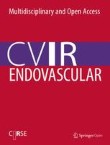CVIR Endovascular is an official journal of the Cardiovascular and Interventional Radiological Society of Europe
Transsplenic portal vein recanalization and direct intrahepatic portosystemic shunt placement to optimize liver transplantation
Percutaneous trans-splenic portal vein recanalization (PVR) has been reported for facilitation of transjugular intrahepatic portosystemic shunts (TIPS), however has not been applied to patients undergoing dire...
